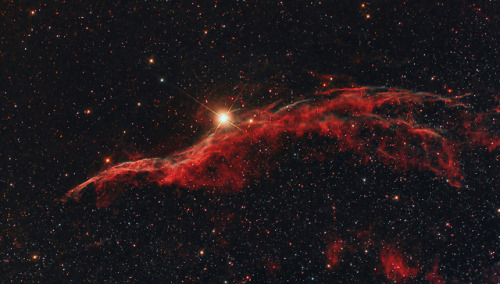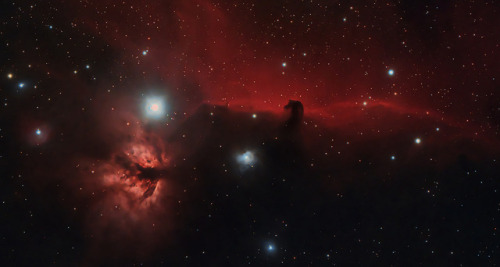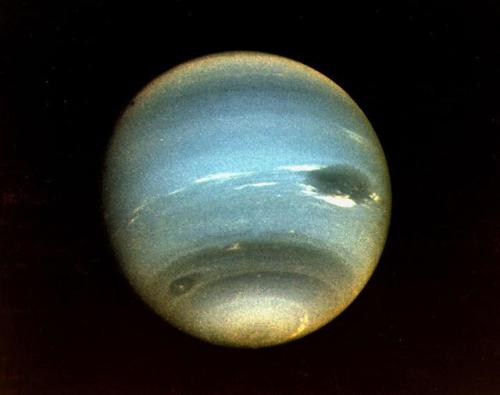OSIRIS-REx View Of Earth And Moon

OSIRIS-REx view of Earth and Moon
This color composite image of Earth and the Moon was taken October 2, 2017, 10 days after OSIRIS-REx performed its Earth Gravity Assist maneuver, using MapCam, the mid-range scientific camera onboard the spacecraft. The distance to Earth was approximately 5,120,000 km—about 13 times the distance between the Earth and Moon.
MapCam, part of the OSIRIS-REx Camera Suite (OCAMS) operated by the University of Arizona, has four color filters. To produce this image, three of them (b, v and w) were treated as a blue-green-red triplet, co-registered and stacked. The Earth and Moon were each color-corrected, and the Moon was “stretched” (brightened) to make it more easily visible.
via: The Planetary Society
image: NASA / GSFC / University of Arizona
More Posts from Xyhor-astronomy and Others
Take in the Surreal Beauty of Jupiter in These Incredible New Images NASA released the raw data earlier this week, allowing the public to process the beautiful images

Composed of gas and dust, the pictured pillar resides in a tempestuous stellar nursery called the Carina Nebula, located 7500 light-years away in the southern constellation of Carina.
Credit: NASA, ESA and the Hubble SM4 ERO Team

A wispy and filamentary cloud of gas and dust, the Crab nebula is the remnant of a supernova explosion that was observed by Chinese astronomers in the year 1054.
The image combines Hubble’s view of the nebula at visible wavelengths, obtained using three different filters sensitive to the emission from oxygen and sulphur ions and is shown here in blue. Herschel’s far-infrared image reveals the emission from dust in the nebula and is shown here in red.
Credit: NASA/ESA/Hubble


What are Pulsars?
Pulsars are spherical, compact objects that are about the size of a large city but contain more mass than the sun. Discovered in 1967, pulsars are fascinating members of the cosmic community.
From Earth, pulsars often look like flickering stars. On and off, on and off, they seem to blink with a regular rhythm. But the light from pulsars does not actually flicker or pulse, and these objects are not actually stars.
Pulsars radiate two steady, narrow beams of light in opposite directions. Although the light from the beam is steady, pulsars appear to flicker because they also spin. It’s the same reason a lighthouse appears to blink when seen by a sailor on the ocean: As the pulsar rotates, the beam of light may sweep across the Earth, then swing out of view, then swing back around again. To an astronomer on the ground, the light goes in and out of view, giving the impression that the pulsar is blinking on and off. The reason a pulsar’s light beam spins around like a lighthouse beam is that the pulsar’s beam of light is typically not aligned with the pulsar’s axis of rotation.
Click here to see the animation
Click here to hear the pulsars sound
The Xpand Your Horizons Family just got bigger! Check out the new pages!
Xpand Your Horizons w/ Paleontology: https://m.youtube.com/playlist?list=PLHFUouhBXdXF6kf0dbsVRghNyDzscVcKc
xyhor-paleontology: https://xyhor-paleontology.tumblr.com
Xpand Your Horizons w/ Archaeology: https://m.youtube.com/playlist?list=PLHFUouhBXdXF6kf0dbsVRghNyDzscVcKc
xyhor-archaeology: https://xyhor-archaeology.tumblr.com
Don’t forget to check out the rest of the family too: https://xpandyourhorizons.tumblr.com/xyhor-family


NGC 6960 (Western Veil nebula) & Horsehead Nebula and the Flame Nebula
by David Wills

Planet Jupiter, observed by the Juno probe on September 1, 2017.

Image of the planet Neptune seen by the space probe Voyager 2
Image credit: NASA/JPL

A false-color image of the mid-infrared emission from the Great Galaxy in Andromeda, as seen by Nasa’s WISE space telescope.
Credit: NASA/JPL-Caltech/WISE Team
Low genetic diversity is a problem when you’re founding a new colony, so how would we avoid that on another planet?
-
 egg-cat reblogged this · 7 years ago
egg-cat reblogged this · 7 years ago -
 not-sewkz reblogged this · 7 years ago
not-sewkz reblogged this · 7 years ago -
 xyhor-astronomy reblogged this · 7 years ago
xyhor-astronomy reblogged this · 7 years ago -
 restlesspacing-blog liked this · 7 years ago
restlesspacing-blog liked this · 7 years ago -
 piratekayte liked this · 7 years ago
piratekayte liked this · 7 years ago -
 profanefame reblogged this · 7 years ago
profanefame reblogged this · 7 years ago -
 aquaisces reblogged this · 7 years ago
aquaisces reblogged this · 7 years ago -
 aquaisces liked this · 7 years ago
aquaisces liked this · 7 years ago -
 djjohnnyt reblogged this · 7 years ago
djjohnnyt reblogged this · 7 years ago -
 thegreenjay reblogged this · 7 years ago
thegreenjay reblogged this · 7 years ago -
 mileysyrups liked this · 7 years ago
mileysyrups liked this · 7 years ago -
 cannibal666corpse liked this · 7 years ago
cannibal666corpse liked this · 7 years ago -
 chan4preet liked this · 7 years ago
chan4preet liked this · 7 years ago -
 hey-bug liked this · 7 years ago
hey-bug liked this · 7 years ago -
 cattyfantastic liked this · 7 years ago
cattyfantastic liked this · 7 years ago -
 banditbrineshrimp liked this · 7 years ago
banditbrineshrimp liked this · 7 years ago -
 jacquelinesantiago liked this · 7 years ago
jacquelinesantiago liked this · 7 years ago -
 bicicomrade liked this · 7 years ago
bicicomrade liked this · 7 years ago -
 spacetimewithstuartgary reblogged this · 7 years ago
spacetimewithstuartgary reblogged this · 7 years ago -
 equuzentric liked this · 7 years ago
equuzentric liked this · 7 years ago -
 ricvidrio liked this · 7 years ago
ricvidrio liked this · 7 years ago -
 boldlyno liked this · 7 years ago
boldlyno liked this · 7 years ago -
 banjolol liked this · 7 years ago
banjolol liked this · 7 years ago -
 human-heuristic liked this · 7 years ago
human-heuristic liked this · 7 years ago -
 sciencenerd4-blog liked this · 7 years ago
sciencenerd4-blog liked this · 7 years ago -
 disgruntledtumblee reblogged this · 7 years ago
disgruntledtumblee reblogged this · 7 years ago -
 attilathehoney8 liked this · 7 years ago
attilathehoney8 liked this · 7 years ago -
 girlwiki reblogged this · 7 years ago
girlwiki reblogged this · 7 years ago -
 bandit1a reblogged this · 7 years ago
bandit1a reblogged this · 7 years ago -
 bandit1a liked this · 7 years ago
bandit1a liked this · 7 years ago -
 omoteura liked this · 7 years ago
omoteura liked this · 7 years ago -
 aversivesdhpn reblogged this · 7 years ago
aversivesdhpn reblogged this · 7 years ago -
 hotshoecustoms liked this · 7 years ago
hotshoecustoms liked this · 7 years ago -
 strawberry-wonder reblogged this · 7 years ago
strawberry-wonder reblogged this · 7 years ago
For more content, Click Here and experience this XYHor in its entirety!Space...the Final Frontier. Let's boldly go where few have gone before with XYHor: Space: Astronomy & Spacefaring: the collection of the latest finds and science behind exploring our solar system, how we'll get there and what we need to be prepared for!
128 posts